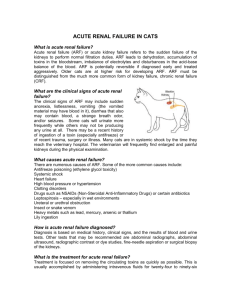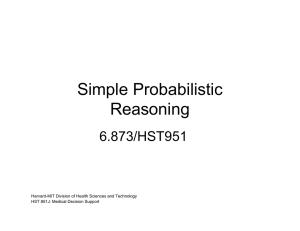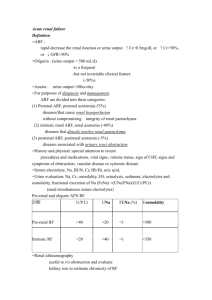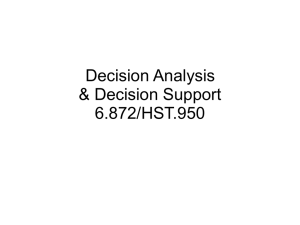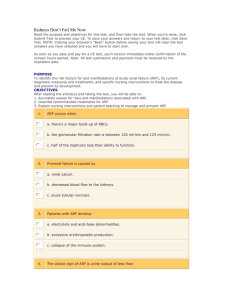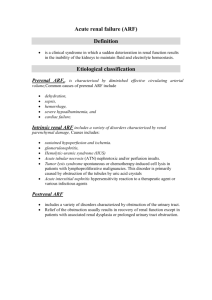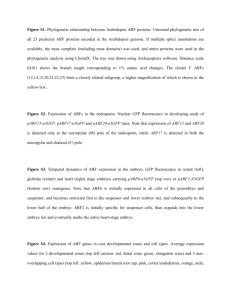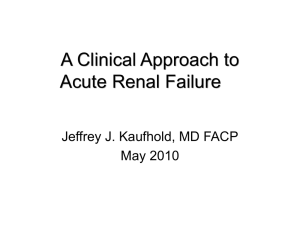General Medical Officer (GMO) Manual: Acute Renal Failure
advertisement
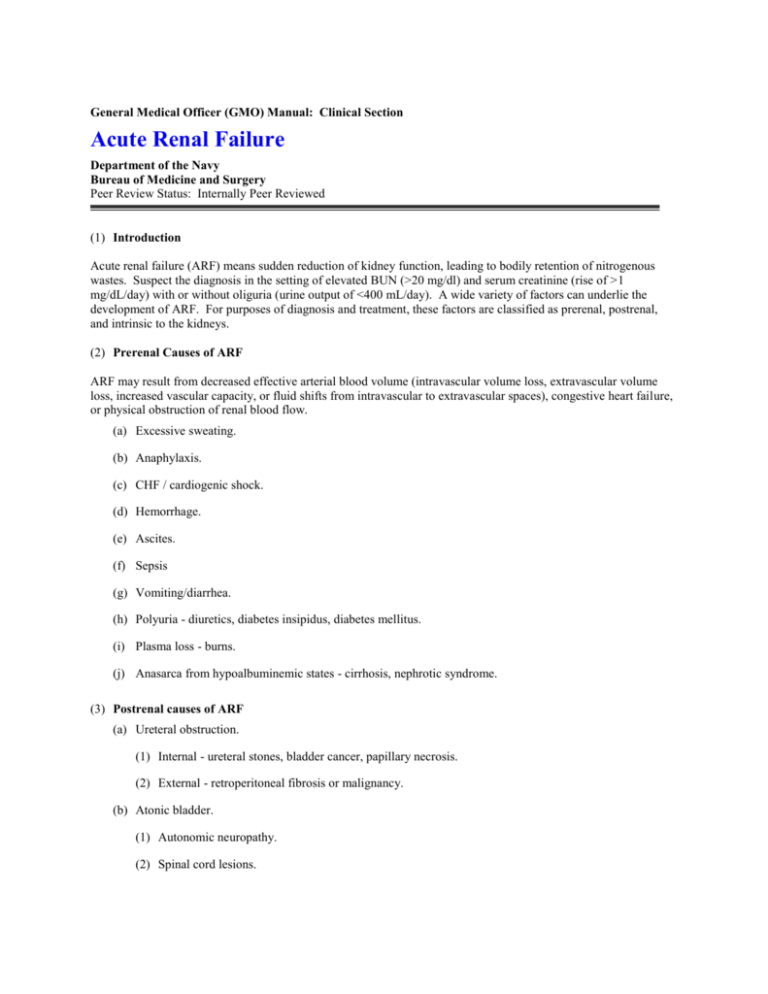
General Medical Officer (GMO) Manual: Clinical Section Acute Renal Failure Department of the Navy Bureau of Medicine and Surgery Peer Review Status: Internally Peer Reviewed (1) Introduction Acute renal failure (ARF) means sudden reduction of kidney function, leading to bodily retention of nitrogenous wastes. Suspect the diagnosis in the setting of elevated BUN (>20 mg/dl) and serum creatinine (rise of >1 mg/dL/day) with or without oliguria (urine output of <400 mL/day). A wide variety of factors can underlie the development of ARF. For purposes of diagnosis and treatment, these factors are classified as prerenal, postrenal, and intrinsic to the kidneys. (2) Prerenal Causes of ARF ARF may result from decreased effective arterial blood volume (intravascular volume loss, extravascular volume loss, increased vascular capacity, or fluid shifts from intravascular to extravascular spaces), congestive heart failure, or physical obstruction of renal blood flow. (a) Excessive sweating. (b) Anaphylaxis. (c) CHF / cardiogenic shock. (d) Hemorrhage. (e) Ascites. (f) Sepsis (g) Vomiting/diarrhea. (h) Polyuria - diuretics, diabetes insipidus, diabetes mellitus. (i) Plasma loss - burns. (j) Anasarca from hypoalbuminemic states - cirrhosis, nephrotic syndrome. (3) Postrenal causes of ARF (a) Ureteral obstruction. (1) Internal - ureteral stones, bladder cancer, papillary necrosis. (2) External - retroperitoneal fibrosis or malignancy. (b) Atonic bladder. (1) Autonomic neuropathy. (2) Spinal cord lesions. (c) Bladder neck obstruction. (1) Prostatic hypertrophy or cancer. (2) Anticholinergic drugs - especially in the elderly patients. (3) Cervical cancer. (4) Intrinsic causes of ARF (a) Tubulointerstitial. (1) Acute tubular necrosis. (a) Ischemia. (b) Toxins. (1) Pigment - hemoglobin, myoglobin. (2) Antibiotics - aminoglycosides, amphotericin. (3) IV contrast agents. (4) Uric acid, hypercalcemia. (5) Heavy metals, solvents, anesthetics. (2) Allergic interstitial nephritis. (3) Pyelonephritis - rarely causes ARF. (b) Glomerulovascular. (1) Vasculitis - Wegener's granulomatosis, polyarteritis nodosa, Henoch-Schonlein purpura, Goodpasture's syndrome. (2) Glomerulonephritis - Poststreptococcal, SLE. (3) Embolic disease - bacterial endocarditis, cholesterol emboli. (4) Malignant hypertension, hemolytic - uremic syndrome, thrombotic thrombocytopenic purpura. (5) Clinical Findings A thorough history and physical exam can aid in finding the underlying cause of ARF. (a) Orthostatic symptoms - dehydration, blood loss, autonomic insufficiency. (b) Orthopnea, postural nocturnal dyspnea, chest pain, ankle swelling - CHF, nephrotic syndrome. (c) Flank pain - stones, papillary necrosis, pyelonephritis, acute glomerulonephritis, arterial emboli, acute renal vein thrombosis. (d) Dysuria, urgency - pyelonephritis. (e) Incontinence - atonic bladder, bladder neck obstruction (overflow). (f) Hematuria - stones, vasculitis, glomerulonephritis, and cancer. (g) Anuria (<50 ml/urine/day) - renal artery occlusion, severe acute glomerulonephritis or vasculitis, ureteral or bladder outflow obstruction. (6) Examination of the Urine in ARF A urinalysis can provide important clues to the etiology of ARF. (a) RBCs - stones, malignancy, glomerular disease. (b) RBC casts - glomerulonephritis, vasculitis. (c) WBCs - cystitis, glomerulonephritis. (d) WBC casts - pyelonephritis. (e) Eosinophils - allergic interstitial nephritis. (f) Tubular cell casts - acute tubular necrosis. (g) Crystals - stones, urate nephropathy. (h) Myoglobin/hemoglobin - on dipstick without hematuria: pigmenturia. (i) Protein on sulfosalicylic acid (SSA)>>dipstick: dysproteinemia (e.g., multiple myeloma). (7) Management Measures In ARF (a) Replace volume deficit and correct hypotension if prerenal. (b) Relieve any outflow obstruction. (c) All drug doses should be adjusted to the level of renal function. (d) Improve cardiac function. (e) Monitor fluid status - diuretics. (f) Hyperkalemia. (1) Dietary potassium restriction: 1.5 to 2.0 grams/day. (2) Avoid nonselective beta-blockers. (3) Calcium gluconate, 10% solution, 10-20 ml IV bolus. May be repeated in 5 minutes if ECG appearance does not improve. (4) Regular insulin 10 units + 50mL of 50% dextrose as IV bolus. (5) Albuterol (5mg/mL), 10-20 mg, nebulized over 10 minutes (6) Kayexalate - 15-30 grams in 50-100 ml of 20% sorbic, orally (g) Sodium Bicarbonate - not needed if >16mEq/L, if <16mEq/L, 32-650 mg TID PO (h) Nephrology consultation. (8) Specific Criteria for Dialysis in ARF (a) Uremic symptoms - severe nausea and vomiting pericardial friction rub. (b) Fluid overload - unmanageable with diuretics. (c) Severe hyperkalemia - K >6.5 mEq/L, ECG changes. (d) Severe acidosis - pH <7.2 untreatable with sodium bicarbonate. (e) Drug overdose - dialyzable drugs only: Lithium, alcohols, salicylates, and theophylline. (9) Summary Acute renal failure can arise from a multitude of causes. Differentiation among prerenal, postrenal, and intrinsic causes proves useful for diagnosis, therapy, and prognosis. Patients may present with many or none of the manifestations of either the cause or the effect of renal failure. With few clinical clues, physicians must recognize the common settings in which acute renal failure develops and must order appropriate tests promptly. With advanced renal disease, severe derangements may necessitate urgent intervention by the nephrologist to stabilize the patient.
